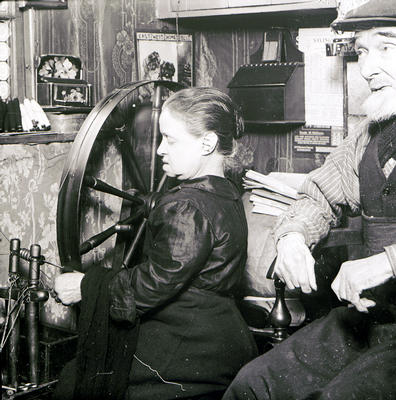
John McDowell and his niece "Wee Maggie" at McDowell's home in Bell Street in 1916. McDowell was apprenticed as a handloom weaver in 1846 at the age of 10. By 1916 he was over 80 years of age and the last working handloom weaver in the Calton area. He is shown here watching his niece working on a spinning wheel.
Handloom weaving became an important industry in the Glasgow area during the 18th century and there were thriving communities of weavers in surrounding villages such as Gorbals, Calton, Anderston and Govan. Handloom weavers were self-employed and worked from home, weaving yarn into cloth, and it was a trade that could provide workers with a good income. However, the rapid development of new technologies during the industrial revolution resulted in the introduction of steam-driven powerlooms which could produce woven goods more quickly and cheaply than the handloom weavers. Wages and living standards fell sharply; in Govan, for example, handloom weavers who could once earn up to £2.10 shillings per week (£2.50) were earning between 5 and 8 shillings (25p-40p) by 1840. The handloom weaving industry declined rapidly thereafter, although a small number of weavers continued until the early 20th century producing fine and delicate cloths.
Reference: 140.78.294
Reproduced with the permission of Glasgow City Council, Glasgow Museums
Keywords:
handloom weavers, spinning wheels, weaving, women
You have 0 images in your photo album.